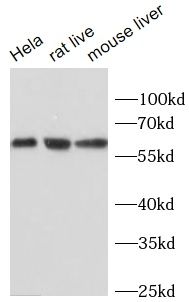Products
XBP1 antibody
| Synonyms: | X-box-binding protein 1 (XBP-1)|Tax-responsive element-binding protein 5 (TREB-5)|X-box-binding protein 1 antibody, cytoplasmic form|X-box-binding protein 1 antibody, luminal form|XBP1|TREB5|XBP2 antibody | ||
| Catalogue No.: | FNab09537 | Reactivity: | Human, Mouse, Rat |
| Host: | Rabbit | Tested Application: | ELISA, WB,IHC |
| Clonality: | polyclonal | Isotype: | IgG |
| Size | Price |
|---|---|
| 100µg | Inquiry |
- SPECIFICATIONS
- FIGURES
- CONDITIONS
- FAQS
- Product Name
- XBP1 antibody
- Catalogue No.
- FNab09537
- Size
- 100μg
- Form
- liquid
- Purification
- Immunogen affinity purified
- Purity
- ≥95% as determined by SDS-PAGE
- Clonality
- polyclonal
- Isotype
- IgG
- Storage
- PBS with 0.02% sodium azide and 50% glycerol pH 7.3, -20℃ for 12 months(Avoid repeated freeze / thaw cycles.)
- Immunogen
- X-box binding protein 1
- Alternative Names
- X-box-binding protein 1 (XBP-1)|Tax-responsive element-binding protein 5 (TREB-5)|X-box-binding protein 1 antibody, cytoplasmic form|X-box-binding protein 1 antibody, luminal form|XBP1|TREB5|XBP2 antibody
- UniProt ID
- P17861
- Observed MW
- 60 kDa
- Tested Applications
- ELISA, WB,IHC
- Recommended dilution
- WB: 1:200-1:1000; IHC: 1:50-1:500
 Various lysates were subjected to SDS PAGE followed by western blot with FNab09537(XBP1 Antibody) at dilution of 1:1000.
Various lysates were subjected to SDS PAGE followed by western blot with FNab09537(XBP1 Antibody) at dilution of 1:1000.
 Immunohistochemistry of paraffin-embedded human liver cancer tissue slide using FNab09537(XBP1 Antibody) at dilution of 1:100.
Immunohistochemistry of paraffin-embedded human liver cancer tissue slide using FNab09537(XBP1 Antibody) at dilution of 1:100.
- Background
- X-box-binding protein 1(XBP1), also named as TREB5, is a 261 amino acid protein, which contains one bZIP domain and belongs to the bZIP family. XBP1 localizes in the nucleus and as a transcription factor is essential for hepatocyte growth, the differentiation of plasma cells, the immunoglobulin secretion, and the unfolded protein response. XBP1 has an association with major affective disorder. The molecular weight of protein generated from the spliced XBP1 mRNA is 54 kDa and protein generated from unspliced Xbp1 mRNA is 33 kDa. This antibody specially recognizes the XBP1S isoform.
How many times can antibodies be recycled?
First, usually it's not suggested to recycle antibodies. After use, buffer system of antibodies has changed. The storage condition of recycled antibodies for different customers also varies. Thus, the performance efficiency of recycled antibodies can’t be guaranteed. Besides, FineTest ever conducted the antibody recycling assay. Assay results show recycling times of different antibodies also varies. Usually, higher antibody titer allows more repeated use. Customers can determine based on experimental requirements.
Notes: After incubation, we recycle rest antibodies to centrifuge tube and store at 4℃. High titer antibodies can be stored for a minimum of one week. Reuse about three times.
What are components of FineTest antibody buffer?
Components of FineTest antibody buffer are usually PBS with proclin300 or sodium azide, BSA, 50% glycerol. Common preservative is proclin300 or sodium azide, which is widely applied in the lab and industry.
How about the storage temperature and duration of FineTest antibodies?
Most antibodies are stored at -20℃. Directly-labeled flow cytometry antibodies should be stored at 2 - 8℃. The shelf life is one year. If after sales issues for purchased antibodies appear, return or replacement is available. Usually, antibodies can be still used after the one-year warranty. We can offer technical support services.
Is dilution required for FineTest antibodies? What’s the dilute solution?
Directly-labeled flow cytometry antibodies are ready-to-use without dilution. Other antibodies are usually concentrated. Follow the dilution ratio suggested in the manual. Dilute solution for different experiments also varies. Common antibody dilution buffers are acceptable(e.g. PBST, TBST, antibody blocking buffer).
How to retrieve antibodies for immunohistochemistry?
Common retrieval buffers: Tris-EDTA Buffer(pH 9.0); Citrate Buffer(pH 6.0)
Heat induced antibody retrieval:
Method 1: Water-bath heating: Put the beaker with retrieval buffer and slide in the boiling water bath. Keep the boiling state for 15min. Naturally cool to room temperature;
Method 2: Microwave retrieval: Put the beaker with retrieval buffer and slide in the microwave oven. Heat at high power for 5min, Switch OFF for 3min, Heat at medium power for 5min. Naturally cool to room temperature.
How to choose secondary antibodies?
(1) Secondary antibodies react with primary antibodies. Thus, secondary antibodies should be against host species of primary antibodies. E.g. If the primary antibody is derived from rabbit, the relevant secondary antibody should be against rabbit. E.g. goat anti rabbit or donkey anti rabbit.
(2) Choose secondary antibody conjugates according to the experimental type, e.g. ELISA, WB, IHC etc. Common enzyme conjugated secondary antibodies are labelled by HRP, AP etc. Fluorescin or dye labelled secondary antibodies are applied in immunofluorescence and flow cytometry(e.g. FITC, Cy3).
